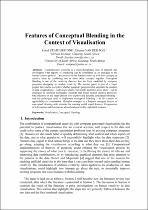JavaScript is disabled for your browser. Some features of this site may not work without it.
- ResearchSpace
- →
- Research Publications/Outputs
- →
- Conference Publications
- →
- View Item
| dc.contributor.author |
Featherstone, Coral

|
|
| dc.contributor.author |
Van der Poel, E

|
|
| dc.date.accessioned | 2017-07-28T08:58:51Z | |
| dc.date.available | 2017-07-28T08:58:51Z | |
| dc.date.issued | 2017-06 | |
| dc.identifier.citation | Featherstone, C. and Van der Poel, E. 2017. Features of conceptual blending in the context of visualisation. ISTAfrica 2017 Conference, Windhoek, Namibia, 30 May - 02 June 2017 | en_US |
| dc.identifier.uri | http://www.ist-africa.org/Conference2017/files/IST-Africa2017_AdvanceProgramme.pdf | |
| dc.identifier.uri | http://hdl.handle.net/10204/9306 | |
| dc.description | ISTAfrica 2017 Conference, Windhoek, Namibia, 30 May - 02 June 2017 | en_US |
| dc.description.abstract | Computational creativity is a multi-disciplinary area of research that investigates what aspects of computing can be considered as an analogue to the human creative process. One premise is that humans come up with new concepts or creative ideas by combining two or more other concepts together. Conceptual blending is one of the creativity theories that has been modelled by computer programs attempting to emulate creativity. The current paper is part of a larger project that wishes to explore whether computer programs that automate the creation of data visualisations – such as pie charts, bar graphs and time series plots – can be enhanced by artificial intelligence methods that model human creative processes. One objective of the larger project is to explore and describe conceptual blending – and the techniques used to implement conceptual blending – in the context of applicability to visualisation. Metaphor emerges as a frequent emergent feature of conceptual blending with potential for creating useful visual features. Compression of information and iteration are shared and potentially exploitable features. | en_US |
| dc.language.iso | en | en_US |
| dc.relation.ispartofseries | Worklist;18629 | |
| dc.subject | Conceptual Blending | en_US |
| dc.subject | Visualisation | en_US |
| dc.title | Features of conceptual blending in the context of visualisation | en_US |
| dc.type | Conference Presentation | en_US |
| dc.identifier.apacitation | Featherstone, C., & Van der Poel, E. (2017). Features of conceptual blending in the context of visualisation. http://hdl.handle.net/10204/9306 | en_ZA |
| dc.identifier.chicagocitation | Featherstone, Coral, and E Van der Poel. "Features of conceptual blending in the context of visualisation." (2017): http://hdl.handle.net/10204/9306 | en_ZA |
| dc.identifier.vancouvercitation | Featherstone C, Van der Poel E, Features of conceptual blending in the context of visualisation; 2017. http://hdl.handle.net/10204/9306 . | en_ZA |
| dc.identifier.ris | TY - Conference Presentation AU - Featherstone, Coral AU - Van der Poel, E AB - Computational creativity is a multi-disciplinary area of research that investigates what aspects of computing can be considered as an analogue to the human creative process. One premise is that humans come up with new concepts or creative ideas by combining two or more other concepts together. Conceptual blending is one of the creativity theories that has been modelled by computer programs attempting to emulate creativity. The current paper is part of a larger project that wishes to explore whether computer programs that automate the creation of data visualisations – such as pie charts, bar graphs and time series plots – can be enhanced by artificial intelligence methods that model human creative processes. One objective of the larger project is to explore and describe conceptual blending – and the techniques used to implement conceptual blending – in the context of applicability to visualisation. Metaphor emerges as a frequent emergent feature of conceptual blending with potential for creating useful visual features. Compression of information and iteration are shared and potentially exploitable features. DA - 2017-06 DB - ResearchSpace DP - CSIR KW - Conceptual Blending KW - Visualisation LK - https://researchspace.csir.co.za PY - 2017 T1 - Features of conceptual blending in the context of visualisation TI - Features of conceptual blending in the context of visualisation UR - http://hdl.handle.net/10204/9306 ER - | en_ZA |






